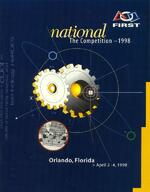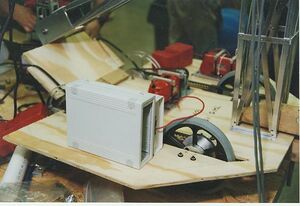1998: Difference between revisions
No edit summary |
|||
| Line 2: | Line 2: | ||
| bodystyle = width:25em; | | bodystyle = width:25em; | ||
| year = 1998 | | year = 1998 | ||
| image = | | image = [https://www.frcarchive.com/index.php?q=post/view/44959 https://www.frcarchive.com/index.php?q=thumb/44959.jpg] | ||
| tag = [https://www.frcarchive.com/index.php?q=post/list/1998/1 1998] | | tag = [https://www.frcarchive.com/index.php?q=post/list/1998/1 1998] | ||
Revision as of 23:34, 12 July 2023
 | |
| Archive tag | 1998 |
|---|---|
| Game Information | |
| Number of official events | 6 |
| Winner | 45 |
| Finalist | 121 |
← 1997 1999 → | |
The 1998 FIRST Robotics Competition season formally began on January 10, 1998 with the kickoff in Nashua, New Hampshire.
Competition season consisted of five regional events and the National Championship at the EPCOT Center at Disney World.
Documentation
Partial game manual and updates
Kickoff
https://www.frcarchive.com/index.php?q=image/44347.mp4
Playing field and scoring
The field is a carpeted modified "T" with three titular Ramps leading up to a platform at the top of the "T". Two uncarpeted Slopes connect the center Ramp with the two side Ramps and a Back Wall and netting separate the drive teams from the field. The top of the T is 30 feet wide and the Raceway extending downwards is 12 feet wide. The total length of the field is 40 feet. The thicker portion of the field including the Ramps and Field Goal is 12 feet long, with angled corners parallel to the Slopes transitioning the platform area to the Raceway. The Raceway includes the four inch tall Speed Bump, flanked by two eight inch tall walls, halfway down its 28 foot length. The platform is four feet square and 30 inches off the ground. The Field Goal is made from two inch inner diameter PVC and is located 15 inches from the front edge of the platform, part way down the front Ramp. The top of the horizontal bar is five feet from the floor, with uprights six feet apart and extending up four feet above the horizontal bar. The field is surrounded by a 4" wooden perimeter with a steel fence installed on top.
Three robots in the red, yellow, and blue positions play simultaneously in the seeding rounds and earlier rounds of playoffs, with two on two matches later on. Robots start lined up facing away from the Ramps and towards the cluster of six balls down the Raceway. Each team has two matching color balls, one 24 inches and one 30 inches in diameter, that start at the end of the field and past the Speed Bump. To count as scored, the ball must break the vertical place above the horizontal bar of the Field Goal uprights. Scoring a 24 inch ball is worth two points and scoring a 30 inch ball is worth three points. The team that matches the color of the ball, not necessarily the team that scored it, receives the points. Tiebreaks are determined first by the large colored ball at the highest elevation from the floor and then by the large colored ball closest to the center of the platform.
Each match lasts two minutes. The control system is automatically enabled and disabled when matches begin and end.
Game strategy
Because robots started under the three-point ball of one of their opponents (or their only opponent in the 1 on 1 matches), a common opening move was to extend upwards and knock the three-point ball off the rungs. The bulk of match play often focused on human players and robots trying to get as many point doublers into the center goal as possible to ensure a good stackup of doublers before worrying about the balls on the point rungs which were more vulnerable than balls scored in the goal.
Robots could pass balls of an opponent's color to their human player both to take them out of play and to give the human player ammo to toss at opponent's balls on the rungs to try to descore them. Some robots were built to squeeze the balls between the rungs of the goal and ladders to make it harder to knock them out of position, and some human players got good enough at throwing the balls that they could shoot them into the sides of the goal.
Towards the end of the match, play would shift towards more offense on the rungs, with robots often adding a ball to a three-point rung and then camping over it to protect it from the human players or other robots. Human players would also shift focus towards throwing any remaining balls at high-value opponent balls on the rungs, trying to knock them off and leave them with zero points to double from the center goal.
Because of the way the double elimination tournament was structured, the one on one on one elimination rounds would sometimes see two teams focusing on a single harder opponent to try to knock them out before the one on one playoffs began. This two-on-one strategy is what caused team 47, heavily favored to win the championship after three regional wins with the first swerve drive, to be eliminated at Nationals.
Robot construction
As was the norm for the era, the majority of robot components came from the kit of parts or Small Parts catalog. The Small Parts allowance for 1995 was $425, with some of the $500 budget already spent on two high-torque couplings to couple the drill motors to the drivetrain. No more than four pulleys and/or sprockets and 10 feet of belt and/or chain from outside sources could be used, and these components had to be used in the drivetrain. Fasteners were not included in the parts allowance. A DEC LA75 dot-matrix printer was included in the kit, although like previous years the motors and electronics could not be connected to the control system. Robots must fit unconstrained inside a 30 inch tall cylinder that is 36 inches in diameter. Robots could weigh a maximum of 70 pounds including batteries. Adding or removing mechanisms that would "alter the operation of the machine" was not allowed after the first seeding match. Teams that competed at the 1995 New England Tournament were allowed to modify their robots for the five days following the competition.
Robots had to display their sponsor and school name so that judges and referees could identify them during a match. Canonical team numbers were assigned, but were only used to order from Small Parts and pick up kits of parts.
Control system
The transmit side of the control system, with two PC flight sticks and RNET radio [5]
The receiver box (lower middle) and relay box (upper right), with RNET radio, servos, limit switches, and two drill motor battery boxes [6]
The receiver and relay boxes on team 45's 1995 robot
Two off-the-shelf PC flight sticks from were included in the kit of parts. These plugged into the Transmit Box and allowed for three axis of proportional control from each joystick (two for the joystick itself and a third for a thumb wheel) with two digital buttons on each joystick.
The receiver box included a BASIC Stamp like the 1997 control system and could be programmed using PBASIC.
Team list
| Team number | Team name | Team location | Robot | Archive link |
|---|
![The playing field [1]](/frcwiki/images/thumb/4/42/43375_-_1995.png/222px-43375_-_1995.png)
![Ramp dimensions [2]](/frcwiki/images/thumb/2/25/43378_-_1995.png/250px-43378_-_1995.png)
![Speed Bump dimensions [3]](/frcwiki/images/thumb/d/d1/43379_-_1995.png/250px-43379_-_1995.png)
![Field Goal dimensions [4]](/frcwiki/images/thumb/9/9c/43380_-_1995.png/250px-43380_-_1995.png)
![The transmit side of the control system, with two PC flight sticks and RNET radio [5]](/frcwiki/images/thumb/2/22/43381_-_1995_kickoff.png/300px-43381_-_1995_kickoff.png)
![The receiver box (lower middle) and relay box (upper right), with RNET radio, servos, limit switches, and two drill motor battery boxes [6]](/frcwiki/images/thumb/c/c9/43382_-_1995_kickoff.png/300px-43382_-_1995_kickoff.png)
